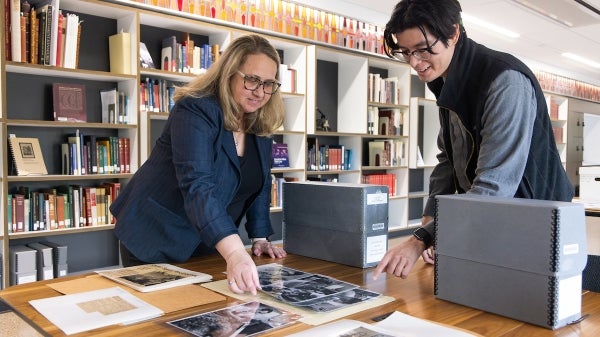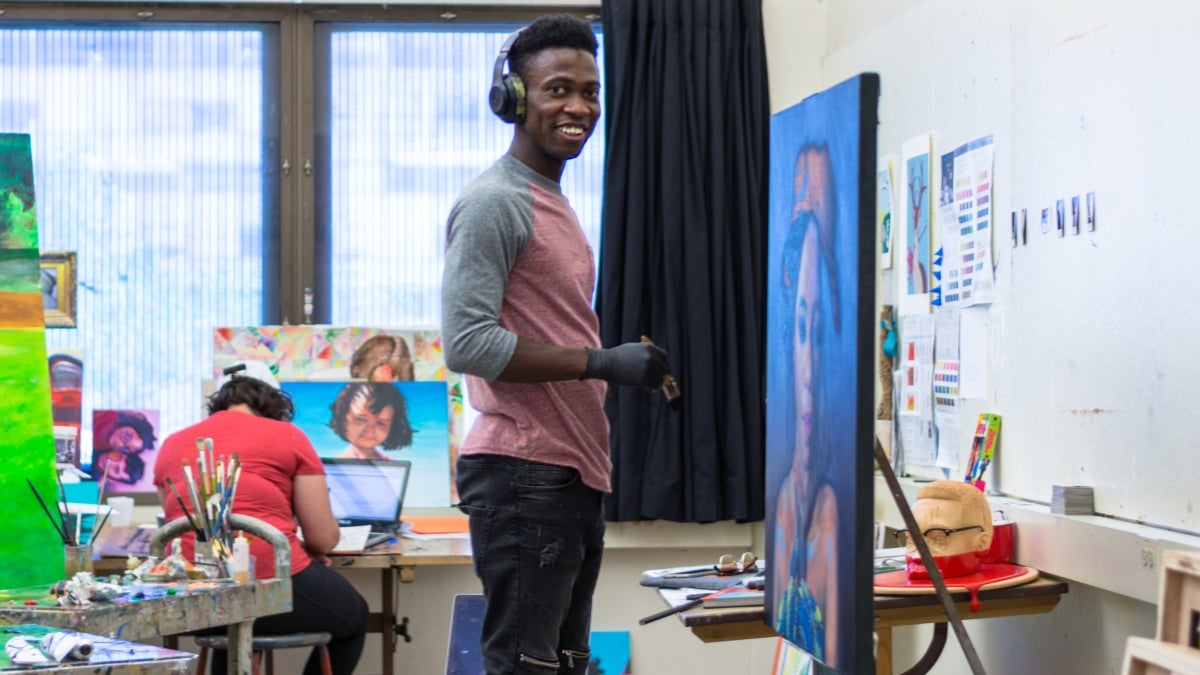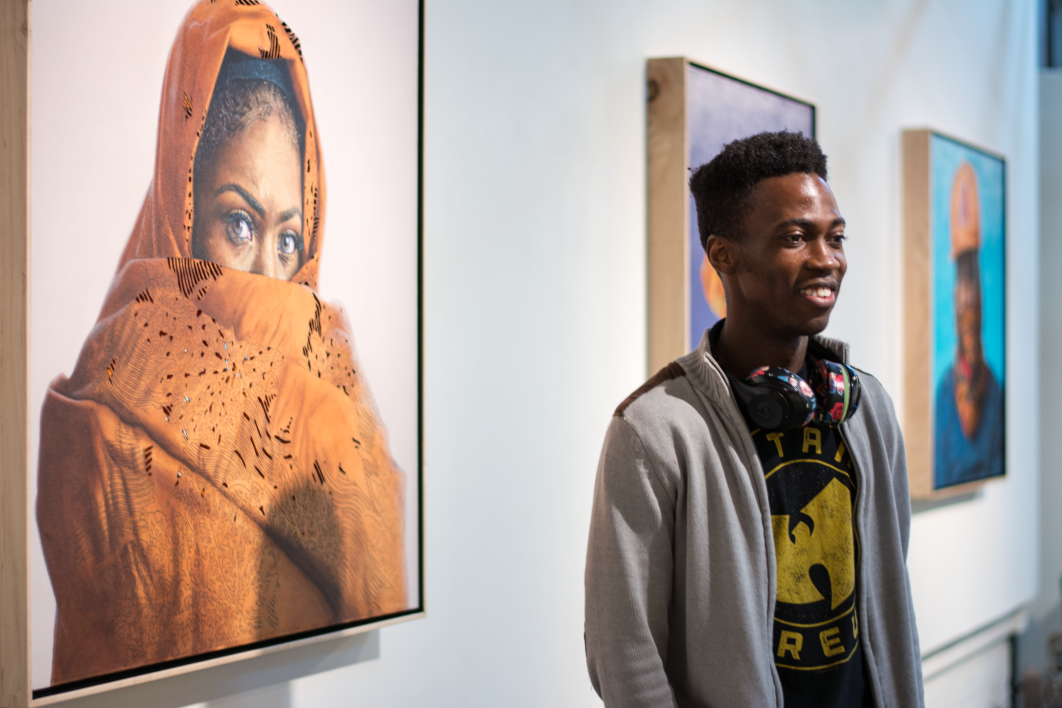Editor’s note: This is part of a series of profiles for spring 2018 commencement.
Papay Solomon knows what it’s like to live in between.
The Arizona State University student, who is graduating with a Bachelor of Fine Arts in painting, has lived between two worlds for almost his whole life. Solomon was born in Africa and has lived in Phoenix since high school.
“At this point, I’m not African enough and I’m not American enough,” said Solomon, whose paintings focus on young African emigres.
“I paint young Africans from the diaspora. So we’re in the new spectrum where only we can relate. I’m trying to tell those stories of the in-betweeness that we all carry.”
Solomon’s paintings are telling the immigrants’ stories in an authentic way.
“Through my years in the states, I don’t feel like the representations of me are accurate. Either on TV or social media, you see people like me referred to as criminals or gangsters and I don’t relate to that,” he said.
“Although a painting can tell more than a thousand words, I wanted to tell more stories. I wanted to push the boundaries. I wanted there to be more than just a painting to learn about these people.”
Solomon, who has been named the outstanding undergraduate in the Herberger Institute for Design and the Arts, was displaced by conflict as a child.
“When my mother was pregnant with me, there was a civil war in Liberia and she had to flee. She gave birth to me in Guinea but I feel Liberian,” he said.
The family moved to the Kouankan refugee camp during civil unrest in Guinea when he was five years old. When the family relocated to Phoenix, Solomon began attending Central High School, where a helpful school counselor found art supplies for him to use. Thanks to a scholarship, he took classes at Phoenix College after graduating from high school. But not in art. He spent an unhappy two years majoring in computer programming
“I was thinking about the financial aspect of things and I wasn’t too sure about art,” he said. “But then I changed my route to painting.”
After earning two associate degrees, he transferred to ASU in 2015, and his art evolved.
“The most important way I grew was that I didn’t want to paint pretty pictures anymore. I wanted my paintings to be about something. That is when I discovered what I was passionate about,” he said.
Solomon is active in the Phoenix refugee community, where he meets other young people from Africa. He interviews them before painting them.
“I want people to know that we, as a people, are brilliant and hardworking. We are willing to do what it takes to contribute to society and make life better for future generations,” he said.
His style, created in oil paint, combines hyperrealism and "non finito," a classical style in which part of the finished work is left unfinished.
“The hyperrealism symbolizes my hyperawareness in the situation I’m in. Being in the middle makes me notice everything.
“'Non finito' is the other end — not fitting in any part. I’m trying to question what it means to be complete.”
Question: What was your “aha” moment, when you realized you wanted to study the field you majored in?
Answer: I’ve known since age 5 that I would be an artist. I was the kid who was doodling on the lined paper notebooks that were handed out by the U.N. instead of taking notes.
During those times I needed a way to figure things out because I didn’t understand what was going on. I discovered art and that was my way of breaking down things and making them more understandable and making it something I could carry, because it was a heavy burden as a 5-year-old.
Q: What advice would you give to a young refugee who wants to go to college?
A: They should follow their heart and never question themselves. Who you are is already established. You need to find who you are and if you start questioning yourself, it’s more likely you’ll follow the wrong path.
Q: What was your favorite spot on campus, whether for studying, meeting friends or just thinking about life?
A: The Art Building. I come to the Art Building and I stay there until midnight or early mornings. It’s where I’ve created a lot of memories. Anywhere else, I need a map.
Q: What are your plans after graduation?
A: I’m thinking about grad school but I’m going to take a year off and just figure things out and work on my body of work.
I’m also working on a documentary series and I’ll spend some time with my video team.
Q: If someone gave you $40 million to solve one problem on our planet, what would you tackle?
A: I would definitely help with education. Because when I was in high school, I didn’t know I would make it to college and I needed help from people to be here today. So I would do the same thing. I would create a surrounding where it would be easy to educate people, where people could focus and be themselves without having to worry about daily struggles.
More Sun Devil community

Dean’s Medalist finds freedom — and a second chance — in literature
When Phoenix resident Wade Sharp was last sent to what he termed “the hole” — solitary confinement in a county jail — he wasn’t sure how long he would be there.“COVID-19 was just starting out,” he…

University Archives chronicles more than 140 years of Sun Devil history
Editor’s note: This is part of a monthly series spotlighting ASU Library’s special collections throughout 2024.What was the name of the butcher who bequeathed the first piece of land that…

3 outstanding ASU alumni named The College Leaders of 2024
Three outstanding Arizona State University alumni from The College of Liberal Arts and Sciences will be named as this year’s slate of The College Leaders. The honor recognizes alumni for their…



